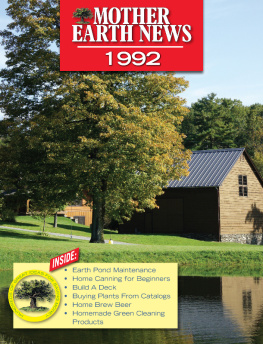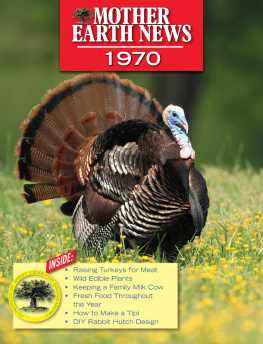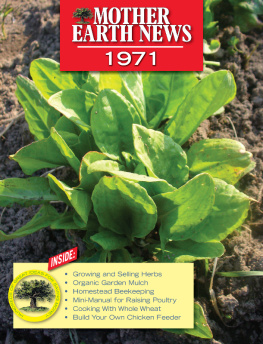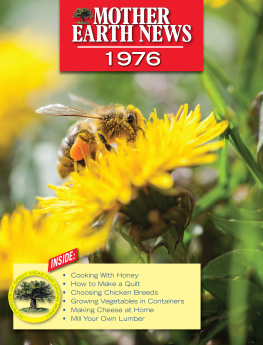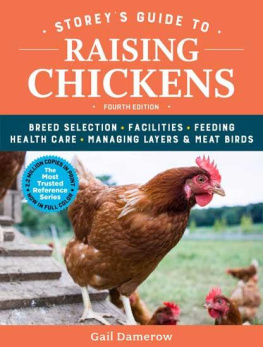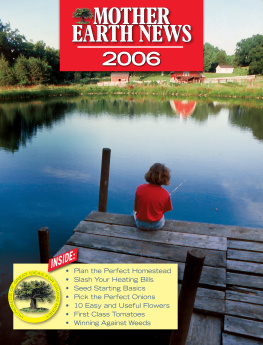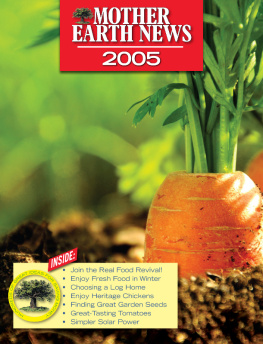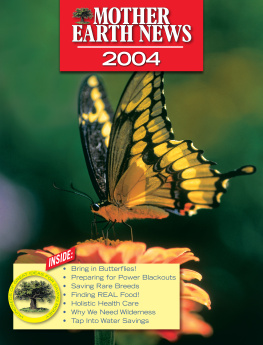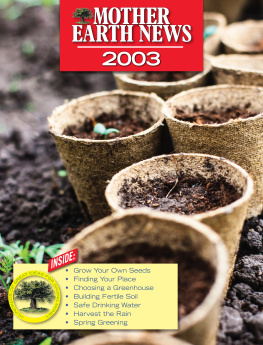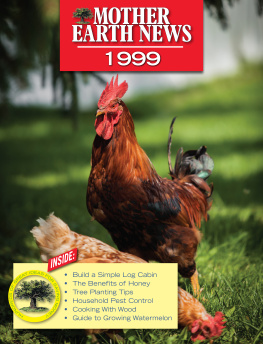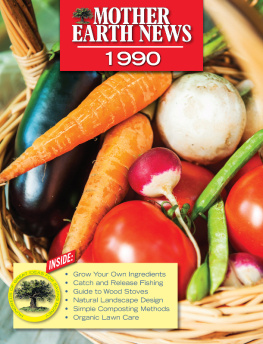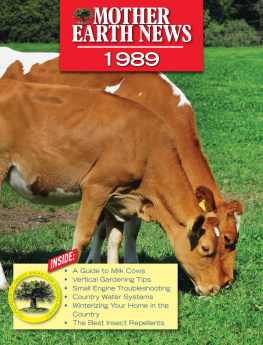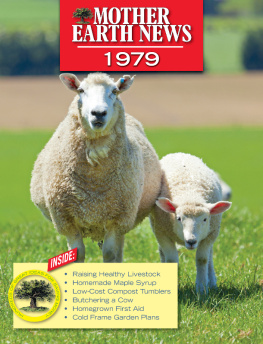Mother Earth News - Mother Earth News 2013
Here you can read online Mother Earth News - Mother Earth News 2013 full text of the book (entire story) in english for free. Download pdf and epub, get meaning, cover and reviews about this ebook. year: 2013, publisher: Mother Earth News, genre: Science / Home and family. Description of the work, (preface) as well as reviews are available. Best literature library LitArk.com created for fans of good reading and offers a wide selection of genres:
Romance novel
Science fiction
Adventure
Detective
Science
History
Home and family
Prose
Art
Politics
Computer
Non-fiction
Religion
Business
Children
Humor
Choose a favorite category and find really read worthwhile books. Enjoy immersion in the world of imagination, feel the emotions of the characters or learn something new for yourself, make an fascinating discovery.
- Book:Mother Earth News 2013
- Author:
- Publisher:Mother Earth News
- Genre:
- Year:2013
- Rating:4 / 5
- Favourites:Add to favourites
- Your mark:
- 80
- 1
- 2
- 3
- 4
- 5
Mother Earth News 2013: summary, description and annotation
We offer to read an annotation, description, summary or preface (depends on what the author of the book "Mother Earth News 2013" wrote himself). If you haven't found the necessary information about the book — write in the comments, we will try to find it.
Mother Earth News 2013 — read online for free the complete book (whole text) full work
Below is the text of the book, divided by pages. System saving the place of the last page read, allows you to conveniently read the book "Mother Earth News 2013" online for free, without having to search again every time where you left off. Put a bookmark, and you can go to the page where you finished reading at any time.
Font size:
Interval:
Bookmark:


If growing your own calorie-free, natural sweetener sounds too good to be true, its time to get to know stevia. Native to Paraguay and other tropical areas of the Americas, the stevia plant (Stevia rebaudiana) produces leaves packed with super-sweet compounds that remain stable even after the leaves have been dried. Stevia leaves have been used to sweeten teas and beverages throughout South America for centuries. More recently, diabetics and dieters alike have turned to stevia to reduce their sugar intake because, unlike honey, maple syrup, agave or molasses, this natural sweetener has zero calories and is not metabolized by the body. Stevia is especially well-suited to sweetening drinks, fruits, salad dressings, yogurt and most creamy desserts. Stevia can substitute for some, but not all, of the sugar used when baking, because it does not provide all of the multiple functions that sugar does.
Many commercial drink mixes and packaged sugar substitutes are sweetened with a derivative of stevia. This sweetening compound is called Rebaudioside A and is listed on labels as either Reb A or Rebiana. These are highly processed products developed by large food corporations. Most of the raw stevia used to produce these products is grown in China. These natural sweeteners have been stripped of many of the plants healthful properties. Teas, extracts and tinctures made from high-quality, whole-leaf stevia, on the other hand, contain up to seven sweet compounds (glycosides) and an array of antioxidants.
Growing stevia is easy in well-drained beds or large containers, and the leaves can be dried for winter use like any other herb. Stevia grows best in warm conditions similar to those preferred by basil. Plants grown in warm climates will grow to 24 inches tall and wide. Where summers are cool, expect stevia plants to grow up to 16 inches. Grow three to five plants for a years supply of dried stevia leaves.
Stevia can be started from seed indoors in late winter, but its best to grow it from rooted cuttings. Germination of stevia seeds tends to be spotty, so keep seed-sown plants under bright lights until the weather warms in spring. Look for stevia plants in the herbs section at garden centers, or locate mail-order suppliers using our Seed and Plant Finder.
Choose a well-drained site, and set out the plants 2 feet apart after your last frost. Be sure to choose an accessible spot, because you will need to gather stems often. Where summers are extremely hot, stevia benefits from slight afternoon shade. Elsewhere, grow stevia in full sun.
Left unpruned, stevia will grow into a lanky, upright plant that produces tiny white flowers in late summer. To maximize leaf production, you must trim back the plants several times to induce branching, first when plants are about 8 inches tall, and again in early summer. You can use the leaves from the pinched-back stem tips, or root them in moist potting soil to increase your supply of stevia plants.
In most areas, you can harvest stevia in midsummer by cutting back the plants by half their size, and again in early fall when new growth slows to a standstill. Stevia can be dried in bunches like other herbs, but you will get better quality by drying it in a dehydrator or a 150-degree- Fahrenheit oven until crisp. Store dried stevia leaves in an airtight container in a cool, dark place. Wait until youre ready to use stevia leaves to crush them.
If you live in Zone 8 or warmer, stevia is often winter-hardy and grows as a short-lived perennial with a protective winter mulch. In colder climates, prepare two healthy parent plants for overwintering indoors. Choose 1-year-old plants grown from seeds or cuttings. Cut them back to about 6 inches, and prune roots as necessary to settle them into 6-inch containers with a light-textured potting mix. Move your stevia plants to a warm, sunny location indoors, or to a heated greenhouse. In spring, when new growth appears, cut most of the new stems and root them in moist seed-starting mix.
You can use the leaves of this healthy sugar substitute fresh or dried, but many people find the flavor improves if the sweet compounds have first been extracted in water or alcohol. With stevia, slightly under-sweetening drinks or fruit desserts tends to taste better than using too much. Too much stevia may impart a bitter or medicinal flavor. (For delectable dessert recipes that use stevia, see Naturally Sweet Stevia Recipes.)
Learn how to use stevia leaves as a versatile, low-calorie sugar substitute with the methods below. Also, use this helpful Stevia-to-Sugar Equivalent Chart.
Stevia Tea. Fill a metal tea ball with 1 rounded tablespoon of dried, lightly crushed stevia leaves. Place in a clean pint canning jar, and cover with almost-boiling water. Steep 10 minutes before removing the stevia. Screw on the lid and keep in the refrigerator for up to 5 days. Yield: 2 cups (16 ounces), sweetness equivalent to about 2 cups sugar.
Stevia Extract. Bring 1 cup water to almost-boiling, add one-half cup lightly crushed stevia leaves. Remove from heat, cover with lid, and steep 40 minutes. Strain through a coffee filter, and pour into a dark-colored container. Store in the refrigerator 1 to 2 weeks. Yield: 3/4 cup (6 ounces), equivalent to 3 cups sugar.
Stevia Tincture. Place one-half cup dried, lightly crushed stevia leaves in a clean glass jar. Add 3/4 cup 100-proof vodka or rum. Screw on the lid and shake. Place in a cool, dark place for two days, shaking the jar twice a day. Strain through cheesecloth or a jelly bag, and place the liquid in a small saucepan. Heat on low until steam rises, and maintain that temperature for 20 to 30 minutes, (do not boil). This creates a more concentrated tincture while removing most of the alcohols taste and smell. Pour the cooled tincture into a dark-colored container. Store in the refrigerator up to 3 months. Yield: About 1/4 cup (2 ounces), equivalent to 6 cups sugar.
Good air circulation is essential for growing stevia in warm, humid climates. Use raised beds if growing this natural sweetener in climates where fungal leaf spot diseases are common. Ensure good drainage in containers by using a light-textured potting mix and containers with large drainage holes.
When first starting to use stevia as a healthy sugar substitute, start with a little and increase the amount gradually and only in small increments.
Take care not to overheat stevia teas or extracts. Such batches may be bitter.
Store stevia tincture in a medicine bottle with a dropper to add it to drinks or prepared dishes by the drop.
Its never too soon to start planning your garden and we have two tools to help you determine the best planting times for your local conditions. Online, our What to Plant Now page shows when each crop should be planted in your region. And, if you have an iPhone or iPad, see our newest app, When to Plant. Just enter your ZIP code and the app will give you recommended planting dates for both indoors and outside for any crop youd like to grow.
Font size:
Interval:
Bookmark:
Similar books «Mother Earth News 2013»
Look at similar books to Mother Earth News 2013. We have selected literature similar in name and meaning in the hope of providing readers with more options to find new, interesting, not yet read works.
Discussion, reviews of the book Mother Earth News 2013 and just readers' own opinions. Leave your comments, write what you think about the work, its meaning or the main characters. Specify what exactly you liked and what you didn't like, and why you think so.


